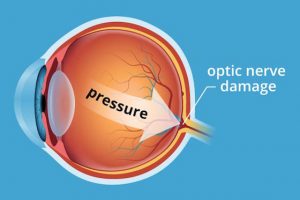Keep an Eye on Glaucoma
 Imagine someone in his mid-forties suddenly has blurred vision, mild headaches, eye pain and sees rainbows or halos. Instead of seeing a doctor, this person shrugs the symptoms off and a small case of feeling under the weather. Without treatment, he slowly loses his peripheral (side) vision. When he finally sees an ophthalmologist, he finds out that he has glaucoma. Don’t be like him and seek help when it is too late.
Imagine someone in his mid-forties suddenly has blurred vision, mild headaches, eye pain and sees rainbows or halos. Instead of seeing a doctor, this person shrugs the symptoms off and a small case of feeling under the weather. Without treatment, he slowly loses his peripheral (side) vision. When he finally sees an ophthalmologist, he finds out that he has glaucoma. Don’t be like him and seek help when it is too late.
Glaucoma is a group of eye diseases that causes damage to your eye’s optic nerve over time, resulting in irreversible vision loss and can eventually lead to blindness. There is no cure for glaucoma yet, but medication or surgery can slow or prevent further vision loss. Treatment depends upon the type of glaucoma and other factors.
Early detection and regular eye exams are essential to slow the progress of glaucoma and prevent further vision loss. According to the Glaucoma Research Foundation, the best way to protect your sight from glaucoma is to get a comprehensive eye examination because in many cases, there are no symptoms of the disease. Anyone can get glaucoma, but the chances are higher for those in the following high-risk groups: African-Americans over age 40, people over age 60 (especially Hispanics), people of Asian descent, those with a family history of the disease and individuals with severe myopia (nearsightedness).
The Glaucoma Research Foundation suggests that your eyes should be tested:
- before age 40, every two to four years
- from age 40 to age 54, every one to three years
- from age 55 to 64, every one to two years
- after age 65, every six to 12 months
- every year or two after age 35 if you are high-risk
The National Eye Institute estimates there are more than 3 million people in the United States who have glaucoma and projects this number will reach 4.2 million by 2030, a 58% increase. Experts also estimate that half of these people don’t know they have it. According to the Glaucoma Research Foundation, in the United States, approximately 120,000 are blind from glaucoma, accounting for 9% to 12% of all cases of blindness. Don’t let “the sneak thief of sight” steal your eyesight. Once vision is lost, it’s permanent. So, keep an eye on glaucoma and take the first step of getting a complete eye exam.
If you or a loved one has glaucoma, visit Carmichael’s to fill prescriptions for eye drops that reduce the pressure in your eye and help keep the pressure at the right level for you, which reduces the risk of vision loss.




 Accredited/Certified by The Joint Commission
Accredited/Certified by The Joint Commission